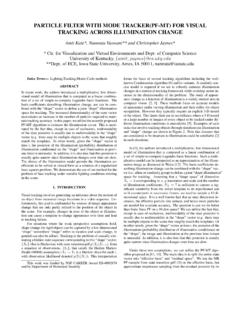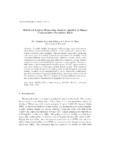Transcription of The Seven Deadly Sins of Communication Research
1 ORIGINAL ARTICLEThe Seven Deadly sins of CommunicationResearchW. Russell Neuman1, Roei Davidson2, Sung-Hee Joo1,Yong Jin Park1, & Ann E. Williams31 Department of Communication Studies, University of Michigan, Ann Arbor, MI 481042 Department of Communication , University of Haifa, Haifa 31905, Israel3 Department of Communication , Georgia State University, Atlanta, GA 30303We analyzed anonymized copies of the complete reviewer comments for 120 recent sub-missions to theJournal of Communicationand attempted to identify the scholarly sins and virtues most frequently mentioned by the reviewers and most closely asso-ciated with the decision to publish the submission. We assessed levels of interrevieweragreement and patterns of evaluation in different subfields of Communication scholar-ship. An explicit connection to a clearly identified theoretical corpus and novel findingsor perspectives proved to be the most important predictors of publication.
2 We discussthe ramifications of these findings for the current state of Communication particularly revealing juncture in the conduct and diffusion of Research onhuman Communication is the peer review exercise the gatekeeper process that isdesigned to determine the scholarly and scientific merit of inquiry in the field. Peerreview is central to the allocation of grants and awards, the tenure process, and, ofcourse, acceptance for publication. Peers turn out to be a rather critical lot. TheJournal of Communication , for example, accepts only about 16% of articles submit-ted. High-quality Research is not easily achieved, and even Communication s mostdistinguished and admired scholars will attest to their personal experience of signi-ficant criticism and the interest of probing how the field of Communication defines quality, weselected one journal, theJournal of Communication , and with the generous cooper-ation of its editors and staff and the approval of the International CommunicationAssociation s oversight publication committee, we obtained carefully anonymizedcopies of 120 recent sets of peer review comments.
3 Our goal was to discern which sinsand which virtues were most frequently identified and which were most closelyassociated with the recommendation for publication. We base our article title onthe notion of the Seven Deadly sins rather than the Seven cardinal virtues becauseCorresponding author: W. Russell Neuman; e-mail: of Communication ISSN 0021-9916220 Journal of Communication58(2008) 220 237 2008 International Communication Associationthe sinful variant is much better known and iconic, but, of course, our primarymotivation is to understand what leads reviewers to identify Research as importantand significant rather than compile some sort of list of miscues or failures. Sinfulnessturns out to be a dominant theme, however, as negative remarks outnumberedpositive ones in our analysis by 9 to Research team initially drafted a list of the sins and corresponding virtuesexpected to define high-quality Communication Research and then to explorewhether such a list adequately captured the content of the review sets.
4 The exercisewas instructive but perhaps na ve. Our subsequent reading of the surprisingly exten-sive Research literature on the dynamics of peer review spanning a broad range ofhumanistic, scientific, and social scientific fields revealed that drafting such a list maybe comparable to reinventing the wheel. The key criteria of scholarly merit arerelatively well developed in the literature and, conveniently, there appear to be aboutseven clusters of peer review literatureThis interdisciplinary literature is robust, diverse, and rather large. One analysttracked down 643 recent academic papers on the peer review process, 101 of whichincluded empirical evidence (Armstrong, 1997). There are extensive studies ofreviewers evaluative criteria and agreement levels in psychology, sociology, econom-ics, educational Research , medical Research , and the physical sciences but, unfortu-nately, very few in Communication . Among the few Communication -oriented studies,there is a tendency to focus on bibliometric data and patterns of citation rather thanevaluation of scholarship ( , Beniger, 1990; Bunz, 2005; Lin & Kaid, 2000; Rice,Borgman, & Reeves, 1988).
5 Bryant and Miron (2004) is a notable the broader literature of the peer review process, two empirical general-izations stand out: (a) the criteria of evaluation are quite similar across academicdisciplines and (b) the journal acceptance rates are not. In the physical sciences, mostjournals accept about 80% of manuscripts submitted, whereas in the social sciences,about 80% are rejected. This was a key finding of the unfailingly cited and seminalstudy in this literature published by sociologists Zuckerman and Merton (1971).Initially, researchers concluded that this was primarily a function of the fact that suchfields as chemistry and physics have well-developed and agreed-upon paradigms ofappropriate topics and methods of analysis that the preparadigmatic and quasi-paradigmatic social and humanistic traditions lack (Braxton & Hargens, 1996). Thisconclusion resonated with our motivating interest in exploring the possible roots ofa common paradigm and defining core of critical questions in Communication .
6 Butas researchers probed further, they discovered that, surprisingly, although criteria ofevaluation were quite consistent across diverse fields, agreement among reviewers onquality was remarkably low regardless of level of paradigm development1(Bakanic,McPhail, & Simon, 1987; Cicchetti, 1991; Cole, Rubin, & Cole, 1977; Hargens, 1988;Scott, 1970; Wolff, 1970). The average interreviewer agreement on quality andW. R. Neumanet Deadly sins of Communication ResearchJournal of Communication58(2008) 220 237 2008 International Communication Association221publishability or worthiness for funding is a correlation coefficient of about .30or roughly 10% of the variance in evaluation explained by commonly agreed-uponcriteria of quality (Cole & Cole, 1981; Hackett & Chubin, 2003). The classic ifsomewhat controversial demonstration of reviewer divergence was a study that took12 recently accepted psychology papers and changed the authors names and insti-tutional affiliations and resubmitted them to the same journals.
7 Three were recog-nized as resubmissions and rejected, but of the remaining nine that were sent out forreview, eight were rejected as unworthy of publication (Peters & Ceci, 1982). Oneeditor admitted: all who routinely submit articles for publication realize the MonteCarlo nature of the review process (Campanario, 1998, p. 191). Indeed, in onestudy, 69% of rejected papers were found to be published elsewhere, sometimes inmore prestigious journals (Chew, 1991).Such results led to a debate in the literature about whether reviewer agreement isactually a worthy goal. Editors, it is argued, solicit diverse reviewers and welcomeevaluations that are complementary rather than replicative (Harnard, 1979). Diver-sity fosters creativity and serves as a counterpoint to an otherwise conservativeprocess that may stifle innovation (Armstrong, 1997).The Seven sins typologyWe proceeded to try to identify the most fundamental and commonly used criteria ofevaluation evident in the peer review literature.
8 Terminologies vary, but the under-lying criteria were surprisingly consistent across studies. A representative sample ofevaluative criteria (including some criteria lists that have been routinized as checklistforms in several journal evaluation procedures) are summarized in Table 1. Thestudies are identified by principal authors across the top banner of the table, andthe Seven terms we ultimately used to identify our Seven sins and corresponding virtuesare listed on the vertical axis with an additional eighth miscellaneous , the first criterion, appeared in some form in virtually all evaluativetypologies and ranks among the most frequently utilized in evaluations. But it mayalso be among the least precise. Some used the term to identify the importance of theunderlying topic addressed, some the novel contribution of the reported Research toa given topic, which we identified (as did others) under a separate heading analysts appeared to equate importance with perceived readerinterest.
9 In the review sets analyzed here, this criterion attempts to capture thereviewer s judgment of the general significance of the broadly defined topic under-taken in the article. Such language often appears as almost ritualized commentaryused by editors and reviewers when rejecting a paper to acknowledge that yes, theissue is important, but the paper does not say anything significant about integrationrefers to the strength of connection between the empiricalor analytic results and the recognized elements of theory. Some typologies simplyused the term theory to identify this clearly central criterion; others used suchphrases as the linkage of concepts to execution. Seven Deadly sins of Communication ResearchW. R. Neumanet of Communication58(2008) 220 237 2008 International Communication AssociationTable 1 Principal Criteria of Scholarly Quality in the Peer Review LiteratureReviewerCriteriaBonjean &Hullum (1978)Bakanic,McPhail, &Simon (1989)Cicchetti(1991)Fiske &Fogg (1990)Straub,Ang, &Evaristo (1994)Petty,Fleming, &Fabrigar (1999)Eisenberg,Thompson,Augir, &Stanley (2002)
10 ImportanceImportantcontributionTopicImpo rtanceGeneral ImportanceTopic selectionImportance/significanceSignific ance,importance,readerinterestTheoretica lintegrationTheoryTheoryLinkage of conceptsto executionTheoryConceptualization/theory/ hypothesisTheoreticalcontributionClarity PresentationWriting styleEditorial & writing,presentationProfessional styleand toneQuality ofwritingMethodologyMethodologyDesign, data,sample,measurement,analysis, resultsScientificreliabilityDesign, procedures,measurement,statisticsStatist ical analysis, Research design,replicabilityMethodology/procedur es/analysesQuality,accuracyof analysisCompletenessCoverage ofsignificantliteratureQuality of literaturereviewAdequacyof literaturereviewNormativeconnectionOrigi nalityImportantcontributionOriginalityCo ntributionto knowledgeMiscellaneousEditorialdiscretio nSuitabilityContribution topractice, adherenceto scientific ethics,length, reputation,future researchAppropriate length,persuasive pointof view, fairness toalternative viewW.






